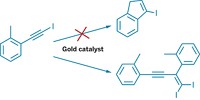Advertisement
Grab your lab coat. Let's get started
Welcome!
Welcome!
Create an account below to get 6 C&EN articles per month, receive newsletters and more - all free.
It seems this is your first time logging in online. Please enter the following information to continue.
As an ACS member you automatically get access to this site. All we need is few more details to create your reading experience.
Not you? Sign in with a different account.
Not you? Sign in with a different account.
ERROR 1
ERROR 1
ERROR 2
ERROR 2
ERROR 2
ERROR 2
ERROR 2
Password and Confirm password must match.
If you have an ACS member number, please enter it here so we can link this account to your membership. (optional)
ERROR 2
ACS values your privacy. By submitting your information, you are gaining access to C&EN and subscribing to our weekly newsletter. We use the information you provide to make your reading experience better, and we will never sell your data to third party members.
Synthesis
Gel Formation Induces Organocatalysis
An L-proline-based compound that forms supramolecular gels also acts as an organocatalyst for the Henry reaction
by Jyllian N. Kemsley
June 8, 2009
| A version of this story appeared in
Volume 87, Issue 23
An L-proline construct that forms supramolecular gels can also act as an organocatalyst, reports Francisco Rodríguez-Llansola, Beatriu Escuder, and Juan F. Miravet of James I University, in Spain (J. Am. Chem. Soc., DOI: 10.1021/ja902589f). The compound, formed by attaching L-proline groups to the ends of an L-valine-based scaffold, aggregates in solvents through multiple hydrogen-bonding interactions to form a temperature-dependent catalytic gel. The researchers found that the proline moieties in nitroethane catalyze the Henry nitroaldol reaction, which they demonstrated by converting the aldehyde group of 4-nitrobenzaldehyde to a nitroaldol group. The reaction proceeded with 99% yield at 5 °C when the system was gelled but didn't work at 25 °C when the system was in liquid form. The researchers propose that the close proximity of the proline groups in the gel allows them to work cooperatively to deprotonate nitroethane, which then adds to the aldehyde group. The tunable nature of such supramolecular catalysts, as well as their easy recovery by filtration, should make them useful for a variety of chemical transformations, the researchers say.






Join the conversation
Contact the reporter
Submit a Letter to the Editor for publication
Engage with us on Twitter